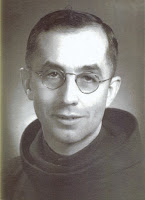One never
knows what one will find in the news, especially when the story is as far away
as England, but started in
the small town of Bethlehem,
CT where our Mother Abbey is.
As a young
novice I can remember going to the lovely home of CAROLYN FERRIDAY on the Bethlehem Green for tea
(do not remember the occasions).
Caroline
( b.1902-90) was the last owner of what is now known as the Bellamy-Ferriday House & Garden, the Bethlehem property
she bequeathed to Connecticut Landmarks. Her parents had purchased the property
as a summer home in 1912 when she was 10 years old. Caroline lived in New York City during the winters and spent summers in Bethlehem, where she was
particularly devoted to her garden and pursued her many philanthropic
interests.
Carolyn was a lifelong
Francophile. Her father, Henry McKeen Ferriday, having himself lived in Paris for several years
as a child, evidently contributed to his daughter’s interest in all things
French, which certainly laid the foundation for the story to follow.
It
was one of the big secrets of the murderous Nazi regime: a camp of 72 female
prisoners used as experiments to test torture techniques. The girls, all high
school-age Catholics from Poland,
were dubbed the 'rabbits' since they were treated like laboratory animals, and
their injuries meant many had to hop instead of walk.
When
they war ended, they were rescued by the Red Cross along with the hundreds of
other prisoners in Ravensbruck concentration camp - but all accounts of their
'treatments' had been destroyed. It meant their ordeal paled into oblivion as
the world grappled to deal with the aftershocks of the Holocaust, particularly
the horrific obliteration of the Jews.
But
the women were finally brought out of the shadows in 1958 by an unlikely fairy
godmother in the guise of our friend and neighbor. She made it her mission to
bring them to the States for medical treatment, a road trip across America, Christmas at her holiday home, and a
dinner with senators in Washington,
D.C.
The
rabbits were not meant to survive; Heinrich Himmler planned to have them all
murdered before word got out. They were brought in to Ravensbruck, 50 miles
north of Berlin,
in August 1942 to test different kinds of surgical procedures. In total,
each underwent six operations, having bones broken, muscle tissue removed,
limbs amputated, and more - all without painkillers. The wounds were then
deliberately infected so the surgeons could test whether sulfonamide - a kind
of penicillin - would cure it.
At
first they operated on male prisoners. Accounts differ on why they switched to
women. Some historians say women were typically healthier prisoners. Others say
Dr. Gebhardt assumed females would be more docile and submissive. Word of
the rabbits leaked outside the walls of Ravensbruck thanks to notes passed from
prisoners to sympathetic guards to their families, and so on.
But
for a number of reasons their cause did not receive widespread attention for more
than a decade. Ravensbruck was one of the last concentration camps to close,
its leaders had more time than most to deal with their incriminating paperwork,
which informed and dictated the schedule of the war trials, and the world was
reeling at the sheer scale of attacks on Jews. Women and Catholics were not
immediately the primary focus.
 |
| Carolyn (Rt.) with four of the Women |
In
the 1950s Carolyn joined the Association of Deportees and Internees of the
Resistance, a group started by four French women, including General Charles de
Gaulle's teenage niece, who were all political prisoners in Ravensbruck. The
women, like many of Europe's underground
resistance workers, were passionate about the rabbits' cause - something Carolyn
had never heard of.
Once
she became aware of the story she flew to Poland to meet with a prosecutor
who represented Jewish victims of the Holocaust, and persuaded him to represent
the rabbits too. She then returned a number of times to meet the women and
gain their trust.
Finally,
she came back with an American doctor, who surveyed each of the victims and
gave a prognosis for what could be done to treat them.
During
that time, Carolyn publicized the cause, raising money for the treatments.
In
December 1958, 35 of the women who wished to go flew to America. They
stayed for a year. They were spread about various cities across the US based on which hospitals were best for their
medical needs.Four of the women spent Christmas in Connecticut with Carolyn.
And
all of them united in San Francisco at the end
of the year to go on a road trip across America,
stopping in Washington, D.C., to be hosted by senators for a dinner.
 |
| Bellamy-Ferriday House |
Genevieve de Gaulle (niece of Charles) wrote a memorial tribute describing
Carolyn as “a sister to everyone. She helped us to gain recognition first, and
then to compensate the victims of pseudo-medical experiments. She brought about
this action with all her intelligence, all her generosity. . . .” A woman of uncommon MERCY.



































